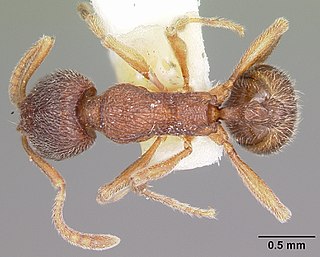
Brachymyrmex is a genus in the ants subfamily Formicinae. The genus can be recognized by the combination of having nine antennal segments and the petiole concealed by the gaster in dorsal view. They are sometimes called "rover ants".

Myrmelachistini is a tribe of ants in the family Formicidae. There are at least 2 genera and 50 described species in Myrmelachistini.

Stenamma chiricahua is a species of ant in the family Formicidae.

Stenamma diecki is a species of ant in the family Formicidae.

Aphaenogaster mariae is a species of ant in the family Formicidae. It nests in dead branches or beneath live bark of oak trees. Male specimens of this species were only discovered in 2021. The species is found in the eastern United States.

Formica oreas is a species of ant in the family Formicidae.

Stenamma brevicorne is a species of ant in the family Formicidae.

Stenamma meridionale is a species of ant in the family Formicidae.

Formica integra is a species of ant in the family Formicidae.

Stenamma schmitti is a species of ant in the family Formicidae.

Brachymyrmex patagonicus is a species of ant in the family Formicidae. B. patagonicus, commonly known as the dark rover ant, is native to Argentina and Paraguay. They were first reported in St. Tammany Parish, Louisiana in 1978 from a single colony collected in 1976. It is believed that the species was introduced through New Orleans, which is a common entry point for many tropical species, but other locations such as Mobile, Alabama, or Pensacola, Florida, are also likely. For many years B. patagonicus, B. musculus, and B. obscurior were misidentified as being separate species but after a comparison of specimens from the Louisiana State University Arthropod Collection (LSUC), it was found that all three were the same species. B. patagonicus is considered a nuisance pest due to their tendency to infest man made structures but they have received a lack of attention because they do not bite, sting, or carry disease.

Formica ravida is a species of ant in the family Formicidae.

Camponotus chromaiodes, known generally as, the ferruginous carpenter ant or red carpenter ant, is a species of ant in the family Formicidae. Acetobacteraceae are found in the guts of workers in this species.

Brachymyrmex minutus is a species of ant in the family Formicidae.

Formica obscuriventris is a species of ant in the family Formicidae.

Formica moki is a species of ant in the family Formicidae.

Camponotus sayi is a species of ant in the family Formicidae.

Formica neogagates is a species of ant in the family Formicidae. Found throughout North America and Canada, introduced in Europe, France.

Brachymyrmex obscurior is a species of ant in the family Formicidae.

Formica archboldi is a species of ant in the family Formicidae. They are known for their abnormal behavior, which includes the collection and storage of Odontomachus (trap-jaw) ant skulls.




























